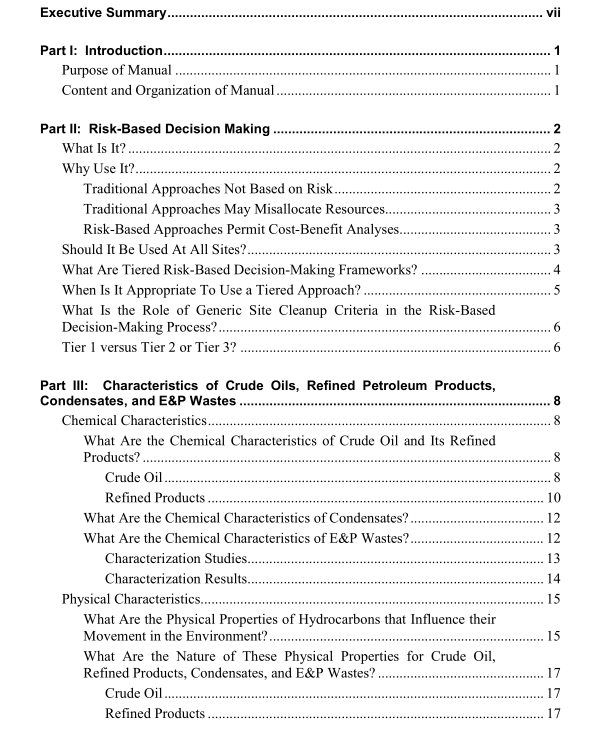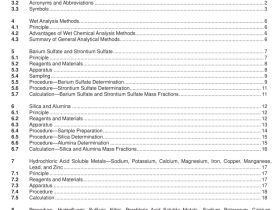API PUBL 4709 pdf download

API PUBL 4709 pdf download Risk-Based Methodologies for Evaluating Petroleum Hydrocarbon Impacts at Oil and Natural Gas E&P Sites Regulatory and Scientific Affairs Department
An understanding of the chemical, physical, and toxicological charac-teristics of crude oils,refined petroleum products,condensates,andE&P wastes is required for the effective application of risk-baseddecision-making. However,most of the available analyses of thesematerials will not support a rigorous assessment of risk. Several recentstudies have improved this situation by providing the necessary data tosupport risk analyses [TPHCWG,1999; Kerr, et al.,1999a; Kerr, et al.,1999b; Magaw,et al.,1999a;Magaw,et al.,1999b;McMillen, et al.,1999a;McMillen,et al.,1999b]. A summary of these chemical,physical, and toxicological data is presented here.
HEMICAL CHARACTERISTICs
WHAT ARE THE CHEMICAL CHARACTERISTIcs oF CRUDE OIL AND ITSREFINED PRODucTs?
In the broadest sense, petroleum hydrocarbons can be divided into twoclasses of chemicals, saturates and unsaturates. The saturates,alsoreferred to as alkanes or paraffins-, are comprised of three main sub-classes based on the structure of their molecules: either straight chains,branched chains,or cyclic. Straight-chain compounds are known asnormal alkanes (or n-alkanes). The branched chain compounds aredesignated isoalkanes and the cyclic compounds, cycloalkanes. [Petro-leum geologists typically refer to alkanes as paraffins and cycloalkanesas cycloparaffins or naphthenes]. Within the unsaturates, there are twomain subclasses,aromatics and olefins. This classification of petro-leum hydrocarbons is summarized in Figure 1.The compounds encom-passed by the classification, aliphatic hydrocarbons, include all of thenon-aromatic compounds shown at the bottom of Figure 1 (i.e.,n-alkanes,isoalkanes,cycloalkanes or naphthenes,and olefins). Aro-matic hydrocarbons are comprised of one or more unsaturated cyclicstructures, or rings. Benzene contains one such ring,while polycyclicaromatic hydrocarbons contain two or more rings (e.g.,phenanthrenehas three unsaturated rings).
Crude oil
Figure 2 describes the major classes of petroleum hydrocarbons that arepresent in crude oil. The primary saturated and unsaturated hydro-carbons consist of n-alkanes,isoalkanes,cycloalkanes, and the mono-,di-, and tri-aromatics; there are no olefins in crude oil. In addition to these saturated and unsaturated hydrocarbons, there are also two non- hydrocarbon fractions (i.e., fractions that contain compounds in addition to carbon and hydrogen such as nitrogen, sulfur, and oxygen). These non-hydrocarbon fractions are the asphaltenes and resins.
The composition of 636 crude oils from around the world have beencompared by Tissot and Welte [1978]. An examination of these datareveals that the proportions of saturates,aromatics,resins,and asphal-tenes can vary dramatically,with the majority of normal crude oilslying within a composition envelope that is bounded in the followingmanner:
40 to 80% saturates15 to 40% aromatics
>0 to 20% resins and asphaltenes
Within these classes of hydrocarbons are compounds that haveanywhere from 1 to more than 45 carbons in their chemical structure.The percentages of these compounds that are present vary among thedifferent crude oils. An illustration of the differences in compositionfor two crude oils can be seen in Figure 3. Gas chromatograms give anindication of the carbon number range and hydrocarbon type (saturatesversus aromatics) for the total petroleum hydrocarbons within acomplex mixture. In this figure, the Widuri crude from Sumatra isdominated by normal alkanes or paraffins that produce a “picket fence”type pattern in the chromatograph which is typical of waxy crude oils.On the other hand, the SJv crude oil from California is dominated by a”hump” or unresolved complex mixture of hydrocarbons that aredifficult for a gas chromatograph to separate. This“hump”isindicative of the prior biodegradation of hydrocarbons that occurred inthe oil reservoir and is a common characteristic for many heavy crudeoils.
Additional composition data for PAHs and heavy metals in crude oilare also presented in other recent references. Specifically, the concen-
tration of the 16 priority pollutant PAHs and 18 heavy metals has beenreported for a number of crude oils [Magaw, et al., i999a; Magaw, etal.,1999b; Kerr,et al.,1999a; Kerr,et al.,1999b]. The analysis ofPAHs in 60 crude oils revealed that the mean concentrations of sevencarcinogenic PAHs were quite low for six of the seven compounds,ranging from 0.06 (indeno(1,2,3-cd)pyrene) to 5.5 (benz(a)anthracene)mg/kg oil. The mean concentration for chrysene was 28.5 mg/kg oil.Naphthalene accounted for as much as 85% of the total PAHs detected.For the metals analyses of 26 crude oils,the mean concentrationsdetected were less than 1.5 mg/kg of oil for all metals except nickel,vanadium,and zinc. The mean concentrations of these three metalswere 20, 63,and 3 mg/kg of oil, respectively.









